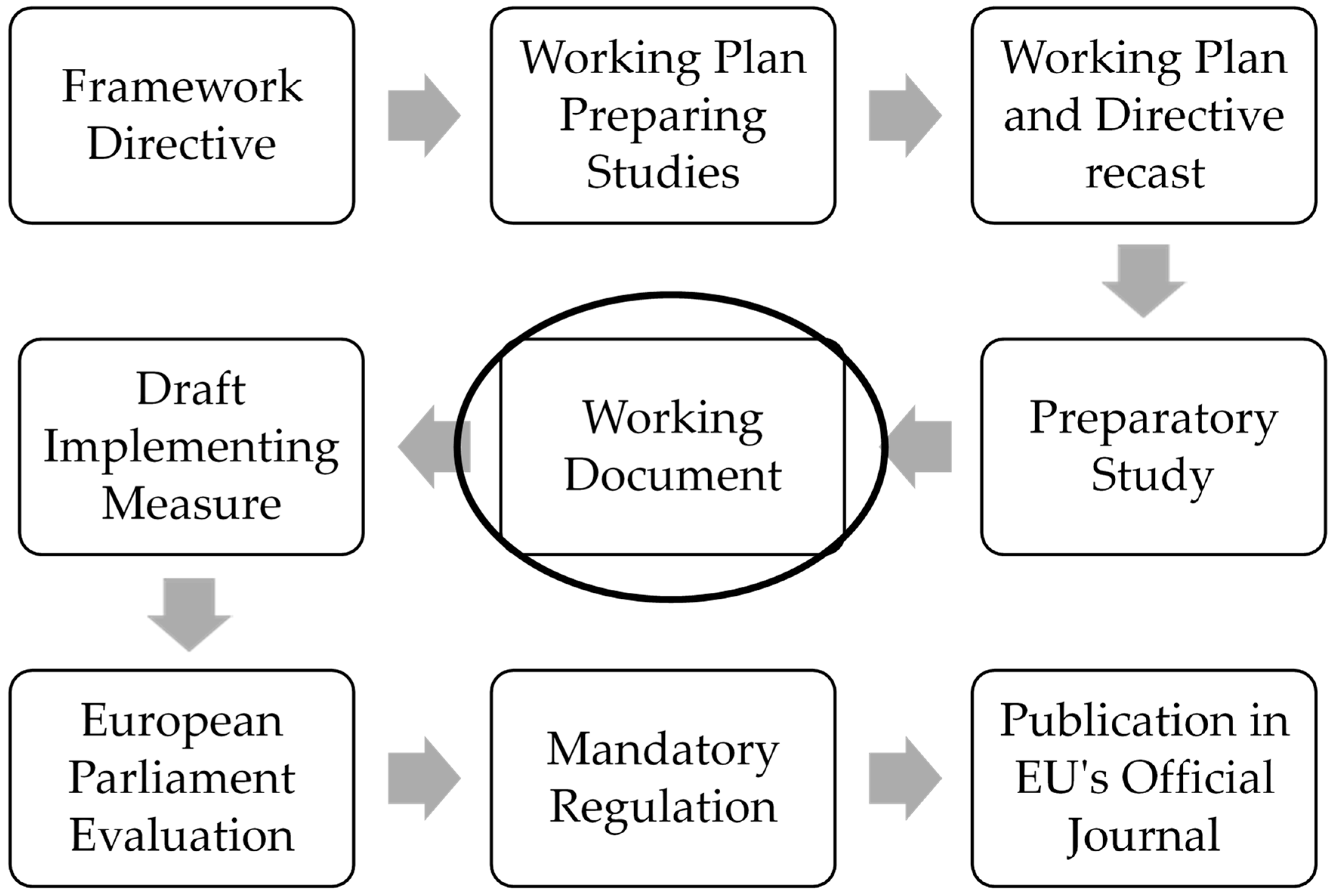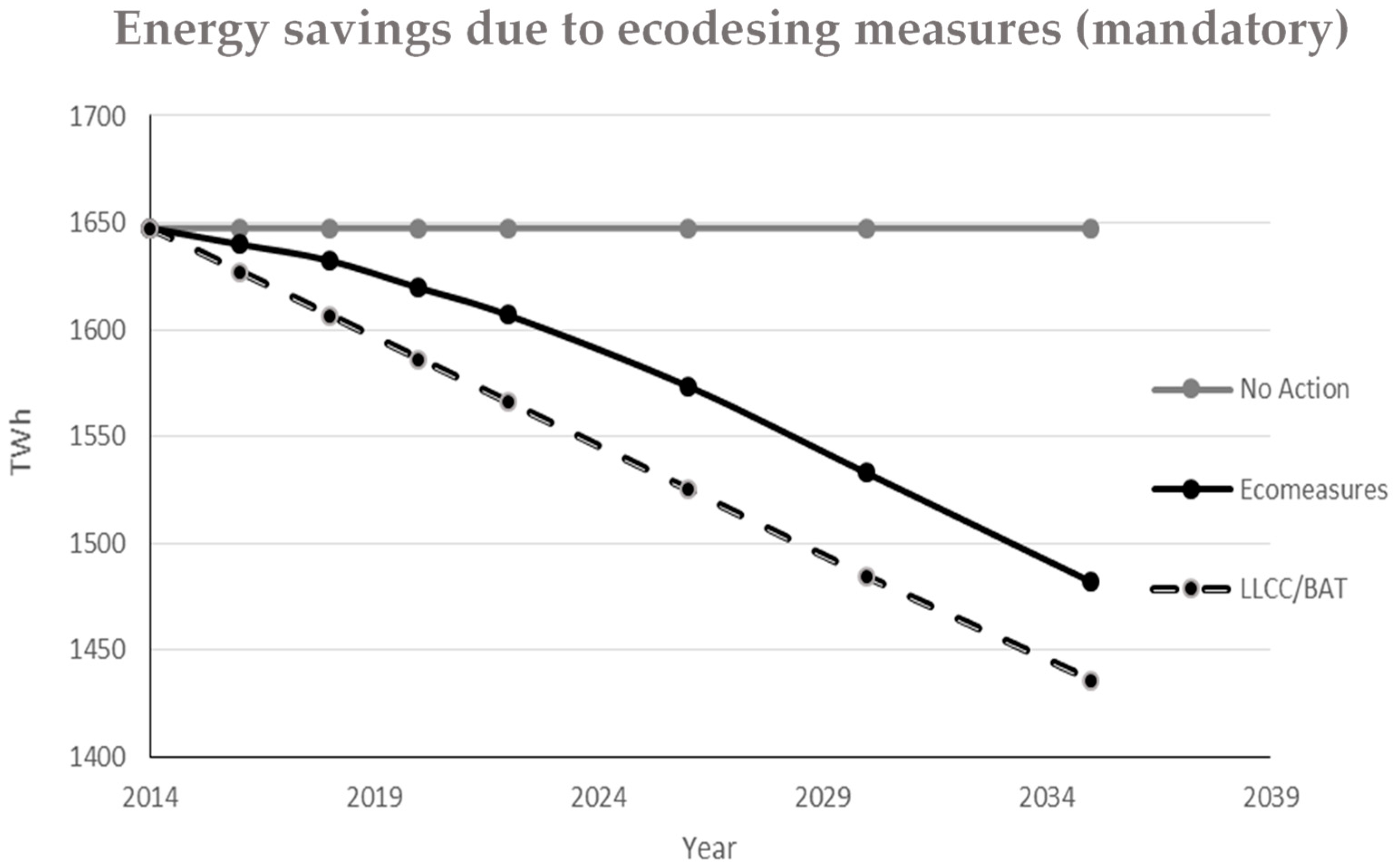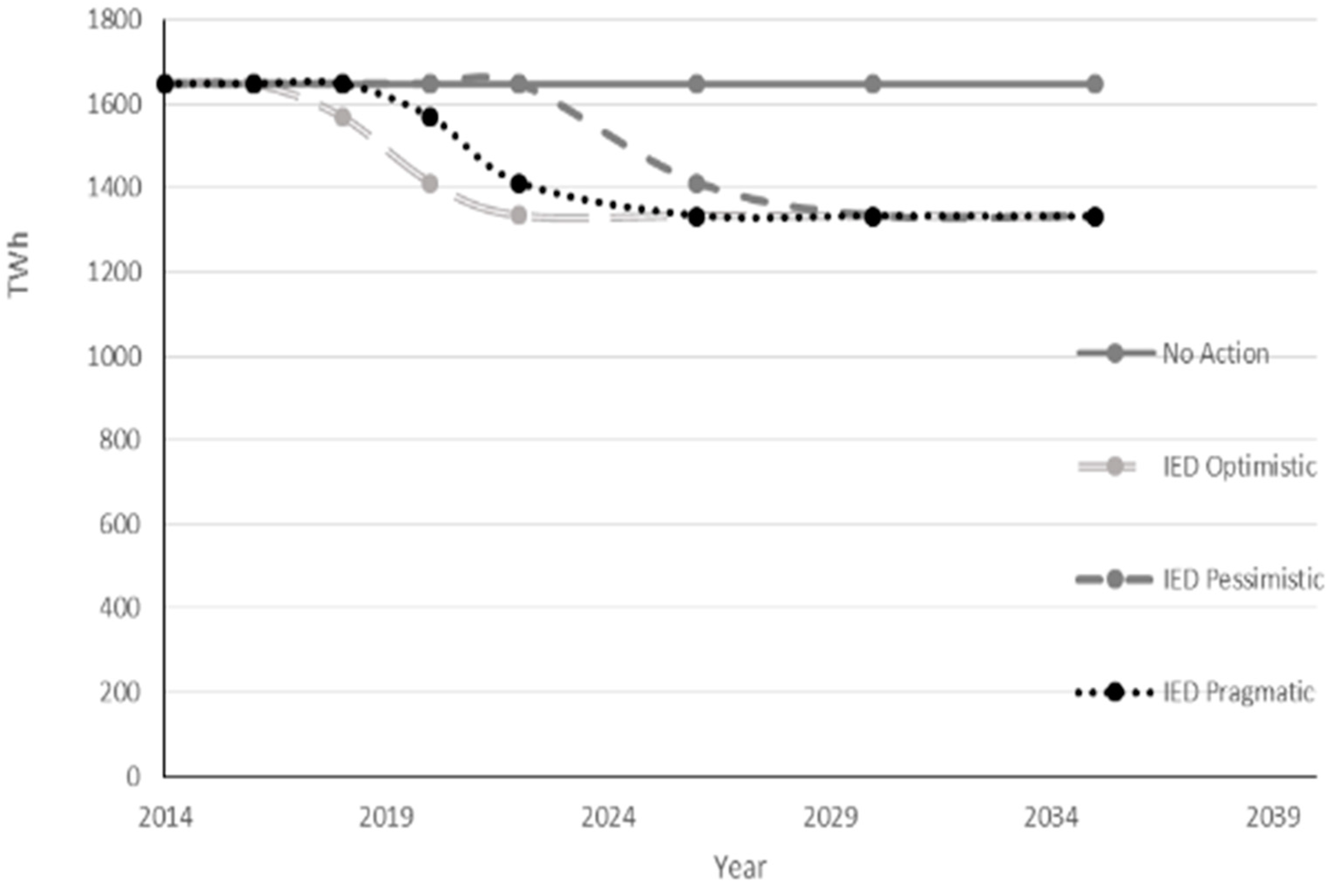Ecodesign for Industrial Furnaces and Ovens: A Review of the Current Environmental Legislation
Abstract
:1. Introduction
2. Base Cases and Environmental Impacts
- BC2a: Medium-size batch oven (electric);
- BC2b: Medium-size batch oven (gas);
- BC3a: Batch chamber furnace (electric);
- BC3b: Batch chamber furnace (gas);
- BC4a: Continuous oven (electric);
- BC4b: Continuous oven (gas);
- BC5a: Continuous belt furnace (electric);
- BC5b: Continuous belt furnace (gas);
- BC6: Large furnace (gas);
- BC7: Very large oven (gas).
- Raw materials use and manufacturing (production phase);
- Distribution phase;
- Use phase;
- End-of-life phase.
3. Implementation of Eco-Scenarios
3.1. Energy Consumption and GHG Emissions
- The no action scenario (referred also as BaU—Business as Usual);
- The policy recommendation scenario: implementation of minimum energy performance standards in three tiers (2014, 2018, and 2024);
- The LLCC (Least Life Cycle Cost scenario): implemented from 2014;
- The BAT (best available technologies scenario): implemented from 2014, expressing the maximum energy-saving potential achievable.
- 5.
- Draft recommendations for base case-specific ecodesign implementing measures that are applicable to Lot 4 furnaces and ovens;
- 6.
- Regulating Lot 4 furnaces and ovens by the Industrial Emissions Directive (IED) sectoral BAT conclusions (greater likelihood of being more effective through sectoral customization) or the Horizontal Energy Efficiency BAT conclusions, via the same “ecodesign-style” requirements. Clearer energy consumption objectives would be provided by this approach, which would improve IED but not interfere with ETS’s “benchmarking” method.
- No action scenario;
- Policy options-related scenarios (Table 4).
3.2. Case Study: Waste to Energy (WtE) Industry—BAT Conclusions of the European Union
- Energy efficiency improving techniques are not novel and may not be suitable for a few facilities/markets;
- Different nature of BAT conclusions and BAT-AELs between 2006 BREF and new BREF (AEL: associated emission levels);
- Different reference for compliance between rules of the IED and BREF (NOC: Normal Operating Conditions; EOT: Effective Operating Time);
- No guidance on how to interpret the BAT-AEL ranges to set new ELVs (Emission Limit Values);
- New potentially complex requirements for waste acceptance procedures;
- Potential challenge to comply with uncertainty requirements when new ELVs are set around the lower end of the BAT-AEL ranges. This is associated with a likely increase in the relative measurement uncertainty (i.e., the uncertainty expressed as a percentage of the measured value) with decreasing emission levels;
- Ambitious requirements for water emissions;
- New rules for bottom ash handling and metal recovery—dry discharge from the bottom ash is suggested.
4. Discussion
5. Conclusions
Author Contributions
Funding
Institutional Review Board Statement
Informed Consent Statement
Data Availability Statement
Conflicts of Interest
References
- Meng, Y.; Yang, Y.; Chung, H.; Lee, P.H.; Shao, C. Enhancing sustainability and energy efficiency in smart factories: A review. Sustainability 2018, 10, 4779. [Google Scholar] [CrossRef] [Green Version]
- Aditya, G.R.; Narsilio, G.A. Environmental assessment of hybrid ground source heat pump systems. Geothermics 2020, 87, 101868. [Google Scholar] [CrossRef]
- Hatzilyberis, K.; Tsakanika, L.A.; Lymperopoulou, T.; Georgiou, P.; Kiskira, K.; Tsopelas, F.; Ochsenkühn, K.M.; Ochsenkühn-Petropoulou, M. Design of an advanced hydrometallurgy process for the intensified and optimized industrial recovery of scandium from bauxite residue. Chem. Eng. Process.-Process Intensif. 2020, 155, 108015–108033. [Google Scholar] [CrossRef]
- Worrell, E.; Biermans, G. Move over! Stock turnover, retrofit and industrial energy efficiency. Energy Policy 2005, 33, 949–962. [Google Scholar] [CrossRef]
- Rodríguez, N.B.; Favi, C. Eco-design guidelines takeaways from the analysis of product repairability and ease of disassembly: A case study for electric ovens. Procedia CIRP 2022, 105, 595–600. [Google Scholar] [CrossRef]
- Kalkanis, K.; Kiskira, K.; Papageorgas, P.; Kaminaris, S.D.; Piromalis, D.; Banis, G.; Mpelesis, D.; Batagiannis, A. Advanced Manufacturing Design of an Emergency Mechanical Ventilator via 3D Printing—Effective Crisis Response. Sustainability 2023, 15, 2857. [Google Scholar] [CrossRef]
- Costa, N.; Fontes, P. Energy-Efficiency Assessment and Improvement—Experiments and Analysis Methods. Sustainability 2020, 12, 7603. [Google Scholar] [CrossRef]
- Barkhausen, R.; Durand, A.; Fick, K. Review and Analysis of Ecodesign Directive Implementing Measures: Product Regulations Shifting from Energy Efficiency towards a Circular Economy. Sustainability 2022, 14, 10318. [Google Scholar] [CrossRef]
- European Commission. Directive 2012/27/EU of The European Parliament and of The Council of 25 October 2012 on Energy Efficiency, Amending Directives 2009/125/EC and 2010/30/EU and Repealing Directives 2004/8/EC and 2006/32/EC, Official Journal of the European Union L 315/1. 2012. Available online: https://energy.ec.europa.eu/topics/energy-efficiency/energy-efficiency-targets-directive-and-rules/energy-efficiency-directive_en (accessed on 15 January 2023).
- European Commission. Directive 2009/125/EC of the European Parliament and of the Council of 21 October 2009 Establishing a Framework for the Setting of Ecodesign Requirements for Energy-Related Products (Recast). 2009. Available online: https://single-market-economy.ec.europa.eu/single-market/european-standards/harmonised-standards/ecodesign_en (accessed on 10 December 2022).
- Bundgaard, A.M.; Mosgaard, M.A.; Remmen, A. From energy efficiency towards resource efficiency within the Ecodesign Directive. J. Clean. Prod. 2017, 144, 358–374. [Google Scholar] [CrossRef]
- European Commission. Directive 2005/32/EC of the European Parliament and of the Council of 6 July 2005, Establishing a Framework for the Setting of Ecodesign Requirements for Energy-Using Products and Amending Council Directive 92/42/EEC and Directives 96/57/EC and 2000/55/EC of the European Parliament and of the Council. 2005. Available online: http://eur-lex.europa.eu/legal-content/EN/TXT/PDF/?uri=CELEX:32005L0032&from=EN (accessed on 18 December 2022).
- European Commission. Communication from the Commission to the Council and the European Parliament, Establishment of the Working Plan for 2009-2011 under the Ecodesign Directive. (COM 2008 660). 2008. Available online: http://eur-lex.europa.eu/LexUriServ/LexUriServ.do?uri=COM:2008:0660:FIN:en:PDF (accessed on 27 February 2023).
- Psomopoulos, C.S.; Kalkanis, K.; Chatzistamou, E.D.; Kiskira, K.; Ioannidis, G.C.; Kaminaris, S.D. End of life treatment of photovoltaic panels. Expected volumes up to 2045 in EU. AIP Conf. Proc. 2022, 2437, 020084. [Google Scholar]
- Goodman, P.; Robertson, C.; Skarstein, A.; Lyons, L.; Pahal, S. Sustainable Industrial Policy—Building on the Eco-design Directive—Energy-Using Products Group Analysis/2. Lot 4: Industrial and Laboratory Furnaces and Ovens –Tasks 1—7 Final Report. (ENTR Lot 4 Final Report). 2012. Available online: http://www.eceee.org/ecodesign/products/Industrial_ovens/043122753%20ENTR%20Lot%204%20Final%20Report%20v6.pdf (accessed on 2 November 2022).
- European Commission. Working Document for The Ecodesign Consultation Forum on Industrial and Laboratory Furnaces and Ovens (Entr Lot 4), 16 MAY 2014 (ENTR/B1/mjb/Lot 4). 2014. Available online: https://www.ebpg.bam.de/de/ebpg_medien/entr4/404_wd_2014-05.pdf (accessed on 3 December 2022).
- Bhadbhade, N.; Patel, M.K. Analysis of energy efficiency improvement and carbon dioxide abatement potentials for Swiss Food and Beverage sector. Resour. Conserv. Recycl. 2020, 161, 104967–104986. [Google Scholar] [CrossRef]
- Pask, F.; Lake, P.; Yang, A.; Tokos, H.; Sadhukhan, J. Industrial oven improvement for energy reduction and enhanced process performance. Clean Technol. Environ. Policy 2017, 19, 215–224. [Google Scholar] [CrossRef] [Green Version]
- Dalhammar, C.; Machacek, E.; Bundgaard, A.; Zacho, K.O.; Remmen, A. Addressing Resource Efficiency through the Ecodesign Directive: A Review of Opportunities and Barriers, 1st ed.; Nordic Council of Ministers 2014: Copenhagen, Denmark, 2014. [Google Scholar]
- Cai, Y.J.; Choi, T.M. Extended producer responsibility: A systematic review and innovative proposals for improving sustainability. IEEE Trans. Eng. Manag. 2019, 68, 272–288. [Google Scholar] [CrossRef]
- European Commission. Directive 2010/75/EU of The European Parliament and of The Council of 24 November 2010 on Industrial Emissions (Integrated Pollution Prevention and Control) (Recast) (Text with EEA relevance). Official Journal of the European Union, 17.12.2010. 2010. Available online: https://eur-lex.europa.eu/legal-content/EN/ALL/?uri=celex:32010L0075 (accessed on 8 January 2023).
- European Commission, Joint Research Centre. Institute for Prospective Technological Studies (IPTS). Reference Documents. Best Available Techniques Reference Document (BREFs). Available online: http://eippcb.jrc.ec.europa.eu/reference/ (accessed on 17 February 2023).
- European Commission. Directive 2003/87/EC of The European Parliament and of The Council of 13 October 2003 Establishing a Scheme for Greenhouse Gas Emission Allowance Trading within the Community and Amending Council Directive 96/61/EC (Text with EEA relevance). 2003. Available online: https://eur-lex.europa.eu/LexUriServ/LexUriServ.do?uri=OJ:L:2003:275:0032:0046:en:PDF (accessed on 1 March 2023).
- European Commission. Annex e of the working Document for the Ecodesign Consultation Forum on Industrial and Laboratory Furnaces and Ovens (entr lot 4), 16 May 2014: Initial Indicative Draft Impact Assessment Energy Savings according to Modelled Policy Options and Furnace/Oven Base Cases. 2014. Available online: https://www.energimyndigheten.se/globalassets/energieffektivisering/produkter-med-krav/ugnar-industriella-och-laboratorie/annex_e_policy_options_final.pdf (accessed on 20 February 2023).
- Psomopoulos, C.S.; Kiskira, K.; Kalkanis, K.; Leligou, H.C.; Themelis, N.J. The role of energy recovery from wastes in the decarbonization efforts of the EU power sector. IET Renew. Power Gener. 2022, 16, 48–64. [Google Scholar] [CrossRef]
- Psomopoulos, C.S.; Limperis, I.; Kalkanis, K. Evaluating the energy demand for municipal solid wastes treatment facilities: A critical approach toward sustainable development. AIP Conf. Proc. 2019, 2190, 020046. [Google Scholar] [CrossRef]
- Kalkanis, K.; Alexakis, D.E.; Kyriakis, E.; Kiskira, K.; Lorenzo-Llanes, J.; Themelis, N.J.; Psomopoulos, C.S. Transforming Waste to Wealth, Achieving Circular Economy. Circ. Econ. Sustain. 2022, 2, 1–19. [Google Scholar] [CrossRef]
- European Commission. Establishing the Best Available Techniques (BAT) Conclusions, under Directive 2010/75/EU of the European Parliament and of the Council, for Waste Incineration (Notified under Document C (2019) 7987). 2019. Available online: https://eur-lex.europa.eu/legal-content/EN/TXT/?uri=uriserv:OJ.L_.2019.312.01.0055.01.ENG&toc=OJ:L:2019:312:TOC (accessed on 15 January 2023).
- European Commission. Waste Incineration. 2006. Available online: https://eippcb.jrc.ec.europa.eu/reference/waste-incineration (accessed on 15 November 2022).
- CEWEP. Explanatory and Guidance Document on Waste Incineration BREF and BAT Conclusions. 2019. Available online: https://www.cewep.eu/wi-bref-guidance/ (accessed on 10 March 2023).
- European Environmental Bureau. EEB Briefing on the Revised EU Standards on Waste Incineration. 2019. Available online: https://meta.eeb.org/wp-content/uploads/2019/11/Waste-Incineration-BATC-2019-briefing.pdf (accessed on 5 January 2023).



| Annual Energy Consumption and GHG Emissions by Furnaces/Ovens in the EU | |||||||||||
|---|---|---|---|---|---|---|---|---|---|---|---|
| Base Cases | BC2a | BC2b | BC3a | BC3b | BC4a | BC4b | BC5a | BC5b | BC6 | BC7 | Total |
| Total Energy (PJ) | 347.00 | 48.67 | 39.17 | 5.49 | 252.91 | 35.37 | 28.30 | 3.97 | 4952.74 | 212.45 | 5926.00 |
| Electricity Consumption (PJ) | 347.00 | 0.01 | 39.03 | 0.00 | 251.35 | 0.04 | 28.25 | 0.00 | 8.87 | 0.43 | 675.00 |
| GHG in GWP100 (million tons of CO2 eq.) | 15.00 | 2.69 | 1.72 | 0.30 | 11.11 | 1.96 | 1.24 | 0.22 | 274.79 | 11.81 | 321.00 |
| Heat Recovery | |||||||
|---|---|---|---|---|---|---|---|
| Size of the Process | Temperature of the Process | Minimum Amount of Heat Recovery per Specific Time Period | |||||
| 2016 and Onwards % Recovered and Reused | 2019 and Onwards % Recovered and Reused | 2025 and Onwards % Recovered and Reused | |||||
| Medium | <1000 °C | - | ≥25% (flue gas ≤ 500 °C) | ≥35% (Flue gas ≤ 350 °C) | |||
| Large | <1000 °C | Flue gas ≤ 600 °C | ≥35% (flue gas ≤ 500 °C) | ≥50% (flue gas ≤ 350 °C) | |||
| Medium | ≥1000 °C | - | ≥30% (flue gas ≤ 550 °C) | ≥40% (flue gas ≤ 400 °C) | |||
| Large | ≥1000 °C | A minimum of 40% heat recovery | ≥40% (flue gas ≤ 500 °C) | ≥55% (flue gas ≤ 300 °C) | |||
| Insulation (heat losses) | |||||||
| Base Case | 2 | 3 | 4 | 5 | 6 (>1000 °C o.t. *) | 6 (450 °C to 1000 °C o.t.) | 7 (< 450 °C o.t.) |
| Mandatory Requirements (W/m2 away from “hot-spots”) | <300 | <300 | <500 | <400 | <500 | <400 | <200 |
| * o.t.: operating temperature | |||||||
| Maximum λ value | |||||||
| Time Period | 2016 and onwards | 2019 and onwards | |||||
| NG | 1.25 | 1.15 | |||||
| LPG | 1.25 | 1.15 | |||||
| Fuel oil | Not yet determined | Not yet determined | |||||
| Type of Furnace/Oven | Average Power Rate (MW) | Energy Consumption (GWh/Year) | Working Hours, Capacity Utilization |
|---|---|---|---|
| Cement rotary kiln | 130 | 1000 | 8000 h/year, 60% |
| Flat glass melting gas | 60 | 156–477 | Continuous for 15 years |
| Rotary ferrous melting furnace gas | 1–4 | 0.2 to 27 | 3650 h/day |
| Rotary non-ferrous melting gas | 1–4 | 0.3–43 (copper) | 3650 h/day |
| Steel wire heat treatment (various, gas) | 1.1–1.5 | 11 | 8000 h/year, 90% |
| Steel wire galvanizing (various, gas) | 0.3–1 | 7.2 | 8000 h/year, 90% |
| Heat treatment aluminum gas | 1–20 | 6.4–128 | 8000 h/year, 80% |
| <1 | 4 | 6500 h/year, 60% | |
| Wall tile kiln | 6 | 14 (estimate) | 8040 days/year |
| Policy Option 1 | Policy Option 2 | ||||
|---|---|---|---|---|---|
| Ecodesign measures (only for sales of new products) | BAT applied through the already existing legislation (IED, etc.)—implemented on existing stock and new sales | ||||
| Three scenarios | Three scenarios | ||||
| Mandatory Ecodesign Requirements (MERs) scenario | Least Life Cycle Cost (LLCC) scenario—only for reference | BAT | Optimistic | Realistic | Pessimistic |
| Three tiers—starting from 2016 (2020 and 2026) | Hypothetically implemented from 2016 | Starts in 2016 | Starts in 2018 | Starts in 2022 | |
Disclaimer/Publisher’s Note: The statements, opinions and data contained in all publications are solely those of the individual author(s) and contributor(s) and not of MDPI and/or the editor(s). MDPI and/or the editor(s) disclaim responsibility for any injury to people or property resulting from any ideas, methods, instructions or products referred to in the content. |
© 2023 by the authors. Licensee MDPI, Basel, Switzerland. This article is an open access article distributed under the terms and conditions of the Creative Commons Attribution (CC BY) license (https://creativecommons.org/licenses/by/4.0/).
Share and Cite
Bourtsalas, A.C.; Papadatos, P.E.; Kiskira, K.; Kalkanis, K.; Psomopoulos, C.S. Ecodesign for Industrial Furnaces and Ovens: A Review of the Current Environmental Legislation. Sustainability 2023, 15, 9436. https://doi.org/10.3390/su15129436
Bourtsalas AC, Papadatos PE, Kiskira K, Kalkanis K, Psomopoulos CS. Ecodesign for Industrial Furnaces and Ovens: A Review of the Current Environmental Legislation. Sustainability. 2023; 15(12):9436. https://doi.org/10.3390/su15129436
Chicago/Turabian StyleBourtsalas, Athanasios C. (Thanos), Petros E. Papadatos, Kyriaki Kiskira, Konstantinos Kalkanis, and Constantinos S. Psomopoulos. 2023. "Ecodesign for Industrial Furnaces and Ovens: A Review of the Current Environmental Legislation" Sustainability 15, no. 12: 9436. https://doi.org/10.3390/su15129436








